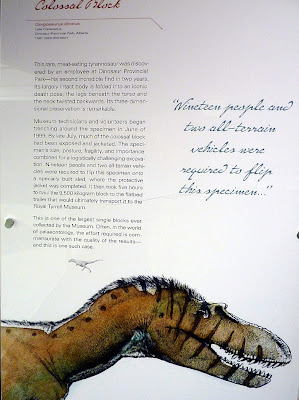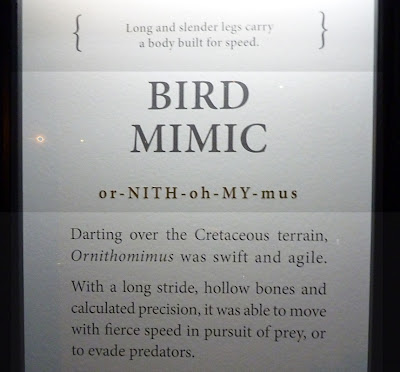We set out the next morning to drive the Dinosaur Trail, a long and skinny oval that traverses both banks of the Red Deer River between Drumheller and the Bleriot ferry. We chose to follow it clockwise, rather than counterclockwise as described in the literature, because we wanted to finish up at the Royal Tyrrell Museum of Paleontology where we would then spend most of the day.
Our first stop on the drive was the Orkney Viewpoint, on top of the bluff overlooking the Red Deer River valley.
The view downstream shows it all: the river, lush farmlands, the bluffs, and the road winding up and down the valley.
Also drinking in the fine morning were two mountain bluebirds. They didn't seem to mind our presence as long as we made no sudden movements.
Here's my best attempt to zoom in on one of the blues, cropping a photo to the limit.
From the Orkney viewpoint it was just a few kilometers to the Bleriot Ferry. The name may sound familiar; the ferry was named after André Bleriot, the brother of the first man to fly across the English Channel, Louis Bleriot.
View Larger Map
The historical sign was instructive (click to enlarge).
When we arrived the ferry was on the far bank.
Several fellows from the adjacent campground strolled over, and we all waited for the ferry to return.
There was plenty of time to admire the river and chat with the ferry operator during our free crossing.
The next stop on the Dinosaur Trail was at Horse Thief Canyon.
This was certainly a badlands, and easy to hide in.
A beggar emerged as we admired the view.
I also took a picture of one of the most common denizens of the Albertan plains.
Our next stop was at the Little Church, built in 1968 both as a roadside attraction and as a place of worship. It was extensively repaired in 1991 by inmates of the Drumheller Institution, a medium-security federal jail that is one of the region's major employers.
The interior is all to scale.
Finally we arrived at the Royal Tyrrell. Given that it was already 10:30, we decided to take the Badlands Interpretive Trail first, before it became even hotter outside. This is the museum's appearance from the rise across the street. It is very modern, having opened in 1985, and was named after Joseph Tyrrell, who discovered the first dinosaur fossil in the Red Deer River Valley in 1884.
This is a montage of the first few signs on the badlands trail (click to enlarge).
The trail was an interesting walk, but we had seen plenty of badlands in the last few days, and it was getting hot. Here is a look back to the museum from the trail.
Joan enters the museum. Note that the panels above the entrance are sunlight filters, not solar panels, which they can be mistaken for from a distance.
As soon as you enter the first exhibition hall, you know you are in a world-class museum. The Queen of England thinks so too, hence the designation Royal Tyrrell Museum, bestowed in 1990. I should note that non-commercial photography was allowed, but without using a flash. Some of my pictures will be grainy.
You can get very close, but do not touch!
Black Beauty is an stunning vertically mounted Tyrannosaurus Rex, whose bones were darkened by minerals. It was discovered in 1980 in a riverbank near Crowsnest Pass, Alberta, and excavation began in 1982. Black Beauty has been around the world, but this is the original, and this is its home.
Then there is the Gorgosaurus:
... and his story (clock to enlarge).
It is natural for the Royal Tyrrell to focus on dinosaurs, but there are many other exhibits, including interactive kiosks, wideo presentations, windows on the laboratories where technicians are preparing specimens, and a reconstruction of a Devonian reef. My favorite of these was a Burgess Shale exhibit, where you walk on a glass floor with 500 million year old "creatures" on the "seabed" underneath.
One striking exhibit was a large, dimly lit room with dinosaurs illuminated by spotlights, and related artifacts in niches along two walls. As Joan and I walked through a Bach Brandenberg Concerto was playing, and these ornithomimus specimens were poised on the floor.
Looming overhead were the deinonychus, with the terrible sickle claws.
Even worse in closeup. Look at those feet!
The botanical side was not forgotten, and we strolled through the Cretaceous Garden, populated by plants that existed in the time of the dinosaurs.
Nor were the sea creatures ignored.
We had already been at the museum for several hours when we wandered into the final exhibit hall. It was a wonder, and any dinosaur fan could spend ages in it. I will simply present a collection of photos that should impart some of the feelings it evoked. The first one shows how the exhibit was organized in rings, rather than aisles.
You can see why most recommendations are to spend several hours at the Tyrrell -- we spent about five, including a lunch break at the useful but uninspired cafeteria.
And with that, I will declare our visit to the Royal Tyrrell Museum of Paleontology complete. Our final day in Alberta will be described in the next post.






































No comments:
Post a Comment
Comments may not appear immediately as they are moderated by the author to eliminate spam. Please, no commercial links!